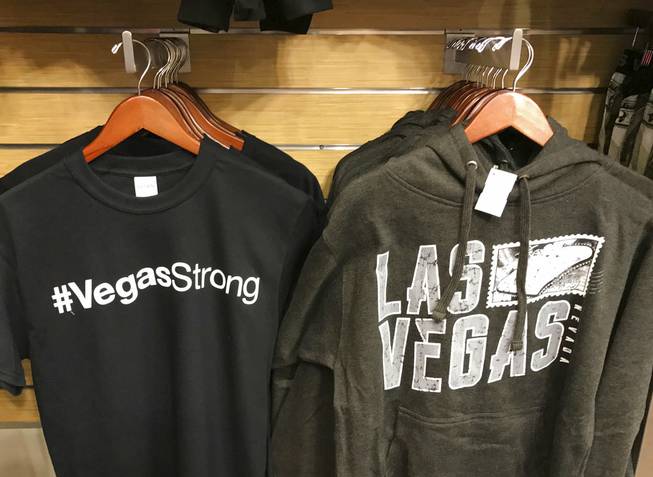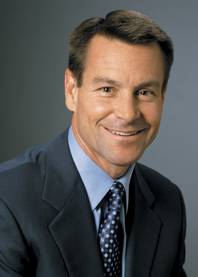
Anita Snow / Associated Press
In this Thursday, Oct. 19, 2017 photo, T-shirts for sale with #VegasStrong hang at a gift shop at McCarran International airport in Las Vegas. Las Vegas has moved to rebrand itself after the Oct 1, 2017, shooting that killed 58 people and wounded hundreds of others. A salesman at the store said proceeds from the sales will go to an official fund to help shooting victims.
Monday, Dec. 25, 2017 | 2 a.m.
Related content
The gatekeepers of the Las Vegas Victims Fund stress that the $22 million they will dole out this spring is a gift.
Not reimbursement for things like medical expenses. Not compensation for lost wages. Simply a gift — given from the hearts and pocketbooks of more than 90,000 empathetic people from around the world, to the people most severely affected by the mass shooting during the Route 91 Harvest Festival.
With guidance from national experts in victim compensation after mass-casualty tragedies, a 17-person committee of locals was tasked with deciding what exactly it means to be most severely affected by the events of Oct. 1. What they decided — and announced Dec. 15 when they released the final distribution plan for the fund — was that eligibility would be based on loss of life and physical injuries.
That means the families of the 58 people who died, as well as possibly more than 500 survivors who were treated for physical injuries related to the shooting, are expected to receive cash payouts sometime in March. Exact amounts will be tiered. Victims with permanent brain damage and/or permanent paralysis requiring continuous home medical assistance will receive the maximum amount, or the same amount as the families of those who died. Others will receive money based on the extent of their injuries and/or the length of their stay in the hospital.
Originally, the distribution plan left out victims who had been treated at a hospital for physical injuries but hadn’t stayed overnight. The eligibility criteria was expanded to include this group after hundreds of people spoke and wrote to the committee requesting their inclusion.
The committee faced an almost impossible task of addressing concerns from across the community.
According to Scott Nielson, chairman of the committee, many wanted money gifted to those suffering from post-traumatic stress disorder and emotional trauma. After the Pulse Nightclub shooting in Orlando, Fla., left 49 dead and dozens more injured in June 2016, a similarly structured victim fund distributed money to people who were inside the nightclub but escaped without physical injuries.
The difference is that Pulse was a small space with a only a few hundred occupants. The Route 91 Harvest Festival occurred on a 15-acre lot filled with 23,000 country music fans, plus event staff and third-party vendors.

Scott Nielson
Vegas Strong Resiliency Center
• Lied Building, Second floor
• 1524 Pinto Lane
• 702-455-AIDE (2433) or 1-833-299-2433
• vegasstrongrc.org
In its official distribution plan, the committee acknowledged this shortcoming. The $22 million raised so far through GoFundMe, National Compassion Fund, Direct Impact Fund and other accounts would amount to less than $1,000 if divided evenly — and the committee has made it clear that won’t be the case. The committee vowed to work with local and state resources to provide resources to people coping with emotional trauma.
Enter the Vegas Strong Resiliency Center.
First launched as the Family Assistance Center at the Las Vegas Convention Center immediately after the mass shooting, the original missions included helping people reconnect with their missing loved ones and receiving information that would assist in identifying those who died. By month’s end, it relaunched as the Vegas Strong Resiliency Center.
Now, two and a half months after the shooting, the center has found a more permanent home on Pinto Lane near the Clark County Coroner’s Office and begun shifting its focus to the changing needs of people affected by the tragedy.
“This is a long-term process,” says Kevin Schiller, assistant county manager. “This is not, ‘We had Oct. 1 and five months out we are done.’ It is a long-term commitment to the victims and recovery.”
The center will likely exist for at least three years and be re-evaluated at that time. For comparison, the Massachusetts Resiliency Center created after the Boston Marathon bombing in April 2013 only recently closed, four years after that attack.
Schiller adds that access to mental health counseling is the most common request from the hundreds of people who have reached out to the center. The center is making sure people reach providers who are qualified to handle the challenging circumstances of trauma.
The extent of needs goes far beyond counseling. Others are dealing with employment issues, such as workman’s compensation, or legal issues related to not having or not being able to do their job. Some just need help prioritizing bills that fell by the wayside while dealing with immediate needs after the shooting. Still more have unique circumstances, such as undocumented immigration status, and need a hand determing what resources they qualify for.
Typically, there are about a dozen people at the center — a few from local social service agencies, a few from state agencies, a Metro Police victim advocate and a therapist.
Parents of one of the deceased victims visited the resiliency center for help filling out paperwork for the Nevada Victims of Crime Program. The couple qualified for income-based social services and left with additional resources for food and transportation.
The center is pushing for all those affected to register with the Nevada Victims of Crime Program by Oct. 1. So far, more than 4,000 have, but those who don’t will be unable to receive financial assistance after that date. The state-run effort helps people with financial costs and has already paid for funerals and insurance copays.
A related message from the center: Even if you don’t currently need help, register because someday you might.
“With this kind of trauma, there are different trigger points,” Schiller said.
Birthdays or anniversaries related to lost loved ones can cause issues, as can fireworks during New Year’s Eve or the Fourth of July. Another day might come when a victim feels as if the community has forgotten about the pain they still grapple with each day.
“People may think they are fine and don’t need to register with the Nevada Victims of Crime, but if they have any (financial or emotional issues) in a year and a half, they need to be registered,” Schiller said.
Schiller added that national statistics suggest 85 to 90 percent of people don’t need outside assistance. But he wants everyone to be prepared if they wind up in a situation where they might.
The center is working on outreach to folks connected to the shooting. Staff are putting together a database and coordinating with third parties like the FBI and vendors who were working at the event to get lists of names and contact info. They are working with an outside firm to do social media and reach people nationally. They are also creating a virtual resiliency center that lists resources in the locations — California being the biggest one — where they know victims are based.
Meanwhile, Metro, medical first responders and the coroner’s office are being connected to the resources of the resiliency center as well.
“We are the hub for the (thousands of people the tragedy affected),” Schiller said. “At the same time, we are trying to evaluate the gaps that aren’t being met. It’s a day-to-day process.”
